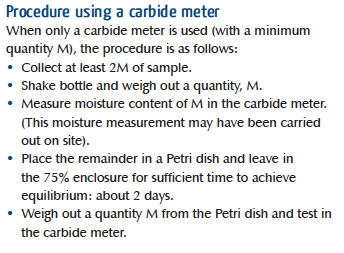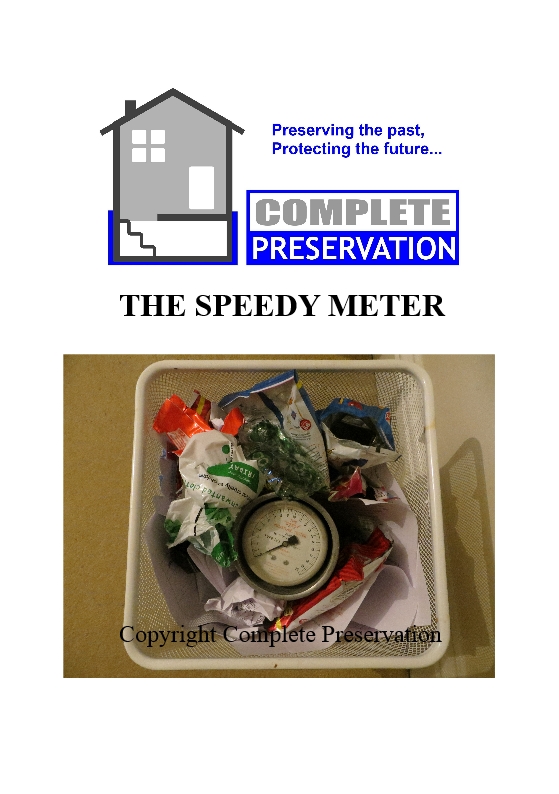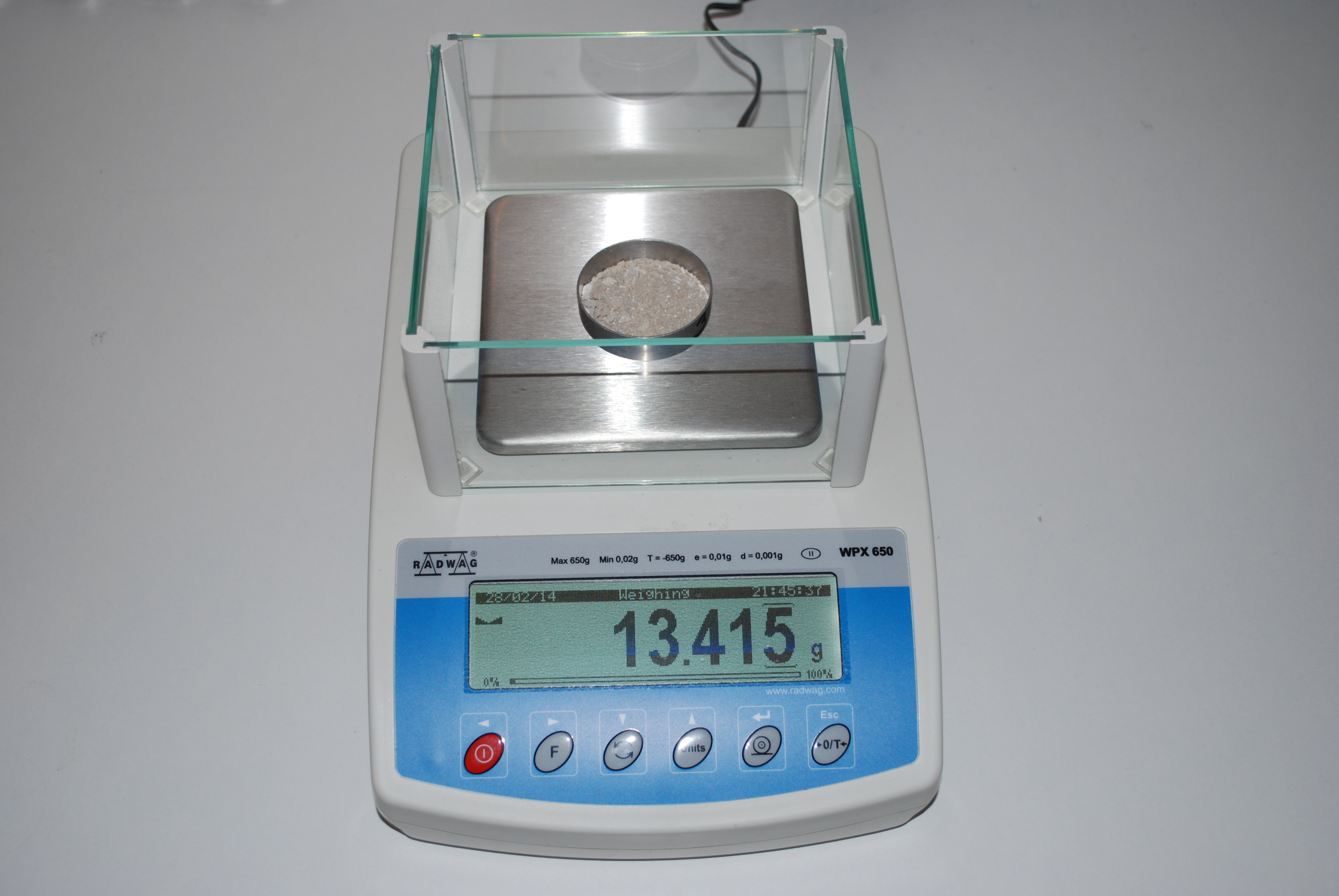This is written as simply as possible, more for the general public to understand, and is to try and educate them on the speedy meter, and how it can – and is used incorrectly.
The Speedy meter-carbide meter is a portable system comprising a vessel with an integral pressure gauge, a weighing scale and a carry case. A small sample of the material is prepared, weighed and placed into the vessel. A reagent is then added and the vessel is sealed and shaken to mix the reagent with the sample. Free moisture within the sample reacts with the reagent to produce a gas and pressure rise within the vessel that is proportional to the amount of moisture. The moisture content value is then read directly from the calibrated pressure gauge.
What is the speedy meter good for?
Testing moisture content of a sample. BRE does approve it, but this is destructive of the sample taken and if you need to profile – as the BRE says, it takes a long time to do all of them properly.
Also the speedy meter will only give total moisture content (TMC %), this is made up of hygroscopic moisture content (HMC %) + free moisture content (FMC %).
This basically means if there has been a long term rising damp problem there will most probably be chlorides and nitrates in the plaster / wall, these are hygroscopic salts mostly from the ground. So when accessing a rising damp problem we need to know how much free moisture is in the wall (FMC, water) and also how much hygroscopic salts are in the wall (HMC, possibly Nitrates & Chlorides), the amount and the distribution vertically up the wall.
I will give you an example, you have a reading of 5% on the speedy meter, what is the free moisture (FMC, water)? What is the hygroscopic salts (HMC)?
It’s impossible to tell, because the speedy meter will only tell you the total moisture content! This is the HMC + FMC = TMC.
If you have a reading of 3%, again it is impossible to tell.
A carbide can be used for hygroscopic testing, but only if you double the size of samples and then subject half the sample to the carbide test and half to the 75%RH and weight test. This means the sample must be well mixed and equal – tricky if it is not homogenous and also the longer you leave it about the more weight it loses or gains before it is analysed.
So why is this important?
It’s important because for diagnosis of rising damp quantitatively on site, a full profile to BRE Digest 245 is impossible with a speedy meter. Samples need to be left in a desiccator for a minimum of 72hrs (sometimes longer if there is a large amount of free moisture) to reach equilibrium @ 75% relative humidity to allow the sample to gain weight if there are hygroscopic salts present. This is not possible on site! A couple of profiles will take to drill and sample around a day that is why only one sample is normally taken by the so-called damp specialist who markets speedy meters as expensive testing equipment…..
The below procedure is actually from BRE Digest 245, this clearly states a carbide meter shouldn’t be used on site only!
Here is an example of a survey that I was recently asked to comment on.
A lady phones up and has already had an independent damp specialist.
She’s very confused because the damp specialist has told her there is no rising damp, but she has damp patches on her wall.
He said there is no rising damp as the speedy meter has said so because the reading is low, 5%.
He also only took 1 sample so this is not profiling like the methodology in BRE Digest 245, this one sample will not give you a profile to show you how much moisture is at the bottom of the wall and how much it reduces as the profile goes up (if it’s rising damp), it will also not separate the free moisture and the hygroscopic salts.
I was also told he had the drill going flat out and his sample was of the brick. The use of the high speed percussion drill is also bad practice – it heats up the sample and causes water-loss, particularly when the sample is relatively dry – for example only 7-8%, this is easier to heat and also the relatively small amount of water loss will adversely effect the carbide test, perhaps by a couple of % or so. The drilling position is also critical – if in the brick it may be lower than the plaster or bed-joint. Also, the methodology of the test is crucial. If the sample is delayed in weighing on site it loses hygroscopic and free water content very quickly, particularly in a warm house. Remember that the sample is from behind plaster in a wall, so is at a higher RH and lower temperature – being drilled at high speed and then messed about with can dry it very quickly.
My observations during my survey were.
On entering the property there was obvious visual damp problems to the ground floor walls at low level, I carried out a survey outside and there was no visible problems that would be causing the rising damp.
Internally I used a moisture meter and carried a profile starting form the skirting board up the wall and the pattern of readings gave a rising damp profile .
My instruction was to carry out a full destructive survey to Bre Digest 245 with soluble salt analysis.
I drilled my profile from just above the floor, and up the wall every 250mm and recorded my moisture meter readings of the surface plaster and also with the deep probes into the wall, this helps me have a greater understanding of a moisture meter once I have my full results from my laboratory analysis.
Samples were recorded and put in a sealed container straight away. A profile must be taken below DPC level or at the floor/wall junction then incrementally up the wall with at least one well above the effected area. All samples ideally must be from the same material for each test for the reasons stated – if necessary a profile from mortar – then brick/masonry then from plaster if required.
So what is the 5% reading?
We don’t know it could all be virtually all free moisture content (FMC = water) or it could all be hygroscopic moisture content (HMC). So we don’t know if it is rising damp still!
Many surveyors claim that 5% is ok!
When used as an on-site instrument (as they mostly are), the investigator is usually looking for moisture contents of less than 5%. Why? Because BRE Digest 245 allegedly says that moisture contents up to 5% are acceptable. Actually, the Digest doesn’t state this at all! It clearly states, “If the found moisture content (MC) is less than 5 per cent at the base, it is unlikely that the wall is severely affected by rising damp” and that “Although only a rough indicator, the five per cent threshold does represent a reasonable general guide to whether or not some kind of remedial treatment is needed. This emphasises the importance of the difference between the HMC and MC measured on samples.” This clearly raises four points: (1) the guidance figure of 5% refers to the base of the wall, not 150mm or above where most samples appear to be removed! (2) these statements have nothing to do with diagnosis – they refer effectively to treatment regimes, (3) you cannot distinguish between MC and HMC on site! and (4) No where in the Digest does it describe or suggest the on-site use of the instrument! Unfortunately, most seem to ignore the above items, or misquote or misinterpret them.
Below is what a profile should look like
| Height (mm)off floor | Material | TotalMoisture Content % | HygroscopicMoisture Content % | FreeMoisture Content % | Chloride | Nitrate |
| 1500 | Joint | 0.6 | 0.6 | 0 | NS | NS |
| 1250 | Joint | 2.2 | 2.0 | 0.2 | ** | * |
| 1000 | Joint | 4.4 | 2.8 | 1.6 | ** | * |
| 750 | Joint | 6.6 | 4.9 | 1.7 | *** | *** |
| 500 | Joint | 9.1 | 1.1 | 8 | * | NS |
| 250 | Joint | 9.2 | 1.2 | 8 | * | NS |
| 50 | Joint | 10.4 | 1.7 | 8.7 | * | NS |
My profile shows rising damp is at at around 1000mm and also the hygroscopic salts show that rising damp has risen to over 1250mm, with the highest concentration of salts at 750mm.
Testing for salts is not part of BRE Digest 245 so why do I test for this?
The salts play a very important role in the diagnosis of rising damp, this is because when a full profile is taken up the wall the distribution of the salts paint a picture and also the type of hygroscopic salt, a salt band will be evident showing the height of rise from rising damp.
If high concentrations of either chlorides and nitrates are present in a wall at 750mm as in the above profile how did they get there? These salts come from the ground!!! If rising damp doesn’t exist how did they get there?
Why can you see them distributed up the wall and stop?
They got there from rising damp!
My opinion of the speedy meter for quantitative diagnosis for rising damp is in the picture below……….
If you need quantitative diagnosis for rising damp, you need to drill a full profile to Bre Digest 245, this is carried by the gravimetric method or also called the oven dry method.
A decent balance is needed to weigh the samples before they go into the desiccator, when they come out, and when they come out the oven.
Samples drying in the gravimetric oven below
The below graph shows graphing using the correct methodology, this data shows exactly the complete distribution of moisture vertically up the wall. Having this data there is no presuming what is going on. The below data was collected from a local Church in Wiltshire. This data was needed to find the actual cause of the rising damp along with associated risks for repairs using lime plaster.
Here is a link to a previous post on BRE Digest 245 blog.completepreservation.co.uk/2014/02/28/gravimetric-damp-testing-and-diagnosis-to-bre-245/
I was fortunate to be trained by My friend Graham Coleman on damp diagnosis, since 1982 he has been in private practice (Remedial Technical Services) as an Independent Consultant specialising in Laboratory and Consultancy services examining dampness and timber infestation/rot problems in buildings; overall he has over 35 years experience of practical scientific site investigations examining dampness and timber infestation problems, especially in recording and analysing materials and data for laboratory and other analyses. www.buildingpreservation.com
My friend Bryan Hindle from Brick Tie Preservation in Leeds is an expert in damp diagnosis using the gravimetric method to BRE Digest 245 www.btpreservation.co.uk
See Bryan Hindle, the Preservation Expert tips on which moisture meter is bestwww.preservationexpert.co.uk/which-type-of-moisture-meter-is-best-for-damp-diagnosis-a-quick-and-simple-appraisal/
Follow us on our social channels where you can get free tips on damp and building defect issues, and you can engage and get your questions answered.
TicTok
TikTokhttps://www.tiktok.com › @complet…Complete Preservation (@complete_preservation)
YouTube
https://youtube.com/@completepreservation
https://instagram.com/complete_preservation?igshid=OGQ5ZDc2ODk2ZA==
https://www.linkedin.com/in/ross-charters-85883b52
https://www.facebook.com/complete.preservation/?locale=en_GB








[…] PS – since writing this I have found a great post on the subject of using the speedy carbide test on site, which includes a nice ‘walk-through’ of the gravimetric process. The post is by Ross Charters CSRT CSSW. He too is a PCA contractor member. He is based in Wiltshire and is one of those I mention above; pushing the envolope to really explore damp diagnosis in depth and using proven and accepted standards. The post is on his Complete Preservation blog […]
An independent company has measured our chimney for damp with the speedy meter, it showed 3%. He said it was dry and nothing to worry about, even though we clearly have a damp area.
What do you think?
Thanks
Hi,
What is the 3% though? It could be 2% hygroscopic salts, and 1% free moisture. It doesn’t tell you what the problem is, and you clearly still have a damp area.